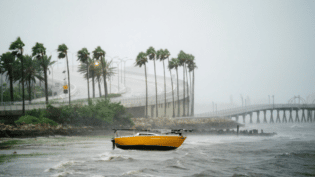Hurricane Ian to Crush Mid-week Business in Florida
By David Moin

Tampa, St. Petersburg, Sarasota, Naples and Orlando are among the major population and retail centers where lives and properties are in jeopardy.
Hurricane Ian, threatening lives and property as it sweeps through western and northern Florida, and through sections of Georgia and the Carolinas, will also wipe out a large swath of retailing for at least a couple of days.
Among the retail chains most impacted due to having a higher percentage of their store base in Florida and the South are Dillard’s, Belk, Cato Stores, Citi Trends, Advance Auto Parts and Hibbet Sports. In some cases, as much as 10 percent to 15 percent of a regional retailer’s base of stores will be closed for at least two days, and could possibly sustain damage due to winds and flooding. Particularly hurt will be those single-unit mom-and-pop stores solely dependent on local populations that started evacuating this week.
National chains like JCPenney and Walmart have scores of stores in the hurricane’s path, but it’s still a relatively small percentage of their total businesses.
“Hurricane Ian will impact much of Florida, including major population centers such as Tampa, St. Petersburg, Naples, Orlando and Jacksonville as well as highly populated markets in the Southeast and mid-Atlantic regions,” Evan Gold, executive vice president of global partnerships and alliances at Planalytics, told WWD. “In addition to heavy rain, flooding, high winds and possibly tornadoes, Ian is likely to bring widespread power outages and dangerous storm surge.”
While the hurricane impact will be significant — it’s the first hurricane to hit Tampa Bay in more than 100 years — this is not a big volume period for retailers considering it’s the middle of the week and not a weekend or holiday period, and back-to-school selling has passed. It’s also still quite warm in the South so fall selling wouldn’t necessarily be very big.
At midday Wednesday, Walmart had a total of more than 200 stores and warehouse clubs closed. “The safety of our associates, customers and members is always our top priority,” Walmart indicated in a statement. “Walmart’s Emergency Operations Center is monitoring Hurricane Ian in real-time, assessing the status of our facilities in the path of the storm. We will continue operating as long as it is safe to do so.
“A map has been built to assist our customers and the communities we serve to help them plan for the storm and possible effects. This map will continue to update in real time to give users the most up to date information available,” Walmart continued. . . .
. . . Gold from Planalytics, which specializes in quantifying the sales impact the weather has on consumer purchasing to help retailers in their planning, said, “During hurricanes and other severe weather events, consumers shift to need-based purchasing involving ‘pantry loading,’ emergency items such as batteries, flashlights, ice and generators, and protective products such as plywood.”
As such, he added, “This won’t be a great week for jewelry store sales, consumer electronics and most apparel.”
However, according to Gold, home centers and hardware stores emerge as the biggest gainers in advance and in the aftermath of the storm for clean-up and repair items. Groceries, convenience stores, dollar stores and quick-serve and drive-through restaurants could also see a lift.
According to Planalytics, other businesses and sectors that experience losses from hurricanes are:
- Entertainment/tourism, shopping malls and outlet centers. (Note that DisneyWorld is closing this week.) An exception to this can be “on demand video” for those stuck at home/sheltering in place.
- Restaurants, particularly fine dining and casual/sit down chains. “In most cases, these are totally lost sales that are not made up,” Gold said. An exception to this can be fast-food chains along evacuation routes.
- Apparel and other speciality retail chains. “An exception to this can be need-based apparel such as rainwear,” Gold said.
Planalytics estimates that three days ahead of the storm, overall revenue can increase by 5 percent to 10 percent above normal sales. Two days ahead of the storm overall revenue can increase by 10 percent to 20 percent above normal sales, and one day ahead of the storm, revenue can increase by 30 percent to 50 percent. Sales of certain specific products, like canned foods, bottled water, batteries, flashlights, ice, wiper blades, can double or even triple, according to Planalytics.
“After the storm, businesses will look to open up as quickly as possible once it is deemed safe to do so,” Gold said. “Agile supply chains are already staging goods outside of the projected impact area to be able to bring post-storm clean up items in and to replenish items that are high in demand such as ice, generators and water.”
To read the full article, Click Here.
